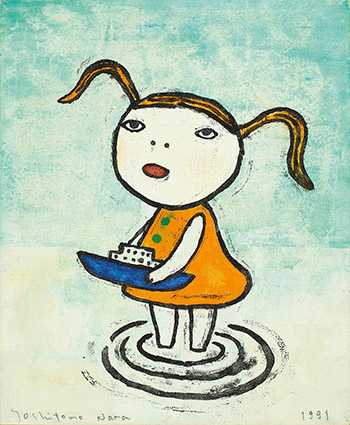Catalogue Note:
Yoshimoto Nara is an internationally renowned artist from Japan, whose work is often presented in a cartoon style, with bright-eyed children being the recurring motif. Nara’s works have often been put in the category of the “Superflat” postmodern art movement attributed to Japanese artist Takashi Murakami, but Nara himself resists this generalization, often publicly expressing that he acquires inspiration from art books for children and the old records his listened to during his adolescence. He once commented that he painted with what he actually felt, and all the reason and meanings ensued afterwards.
“Michi” is one of Nara’s early creations, produced during his stay in Germany. In the painting, the little girl differs drastically from the rebellious and often misanthropic children of his later works, and instead possesses a pair of innocent eyes and an unassuming expression. Tho these wicked-ish looks somehow reflect the nostalgic sentiments of the artist’s. In “Michi”, the girl’s eyes gaze upwards, as if silently praying for a friend or companion to join her and play with the toy boat she clutches in her hands. The title “Michi” is a female name, often adopted by Nara in his social media accounts, and actually belongs to his older sister that unfortunately passed away before childbirth, however, his mother still gave the name to him. Nara has previously expressed that he believes his deceased sister has become a part of him, and will always hold a special place in his heart.
A reoccurring theme that appears in Nara’s characters is that they appear ‘loneliness’ or ‘solitary’. Resulted in Nara’s childhood that his parents were often occupied with work, leaving the artist to fend for himself, and he eventually grew accustomed to being alone. Nara has stated, “All of my works are actually self-portraits; they are basically conversations with myself. As for the source of these paintings, what emerges are memories from my childhood as I retrace these dialogues.” Therefore, the “Michi” in the painting not only represents the merging of the artist and his sister, but also expresses the strong craving for companionship present in his subconscious during his childhood, moreover, the painting could also be considered a self-portrait of the artist and his sister, which the artist subconsciously created. The artist also rarely signed his full name on the front which emphasized how unique and significant the painting stands to him. In the same vein, though many of Nara’s characters have staring eyes in the later works – the gaze often containing a hint of anger or dissatisfaction – this is absent in the 1991 “Michi”, whose loneliness seems to beg for tender love and care.
“Michi” is one of Nara’s early creations, produced during his stay in Germany. In the painting, the little girl differs drastically from the rebellious and often misanthropic children of his later works, and instead possesses a pair of innocent eyes and an unassuming expression. Tho these wicked-ish looks somehow reflect the nostalgic sentiments of the artist’s. In “Michi”, the girl’s eyes gaze upwards, as if silently praying for a friend or companion to join her and play with the toy boat she clutches in her hands. The title “Michi” is a female name, often adopted by Nara in his social media accounts, and actually belongs to his older sister that unfortunately passed away before childbirth, however, his mother still gave the name to him. Nara has previously expressed that he believes his deceased sister has become a part of him, and will always hold a special place in his heart.
A reoccurring theme that appears in Nara’s characters is that they appear ‘loneliness’ or ‘solitary’. Resulted in Nara’s childhood that his parents were often occupied with work, leaving the artist to fend for himself, and he eventually grew accustomed to being alone. Nara has stated, “All of my works are actually self-portraits; they are basically conversations with myself. As for the source of these paintings, what emerges are memories from my childhood as I retrace these dialogues.” Therefore, the “Michi” in the painting not only represents the merging of the artist and his sister, but also expresses the strong craving for companionship present in his subconscious during his childhood, moreover, the painting could also be considered a self-portrait of the artist and his sister, which the artist subconsciously created. The artist also rarely signed his full name on the front which emphasized how unique and significant the painting stands to him. In the same vein, though many of Nara’s characters have staring eyes in the later works – the gaze often containing a hint of anger or dissatisfaction – this is absent in the 1991 “Michi”, whose loneliness seems to beg for tender love and care.
